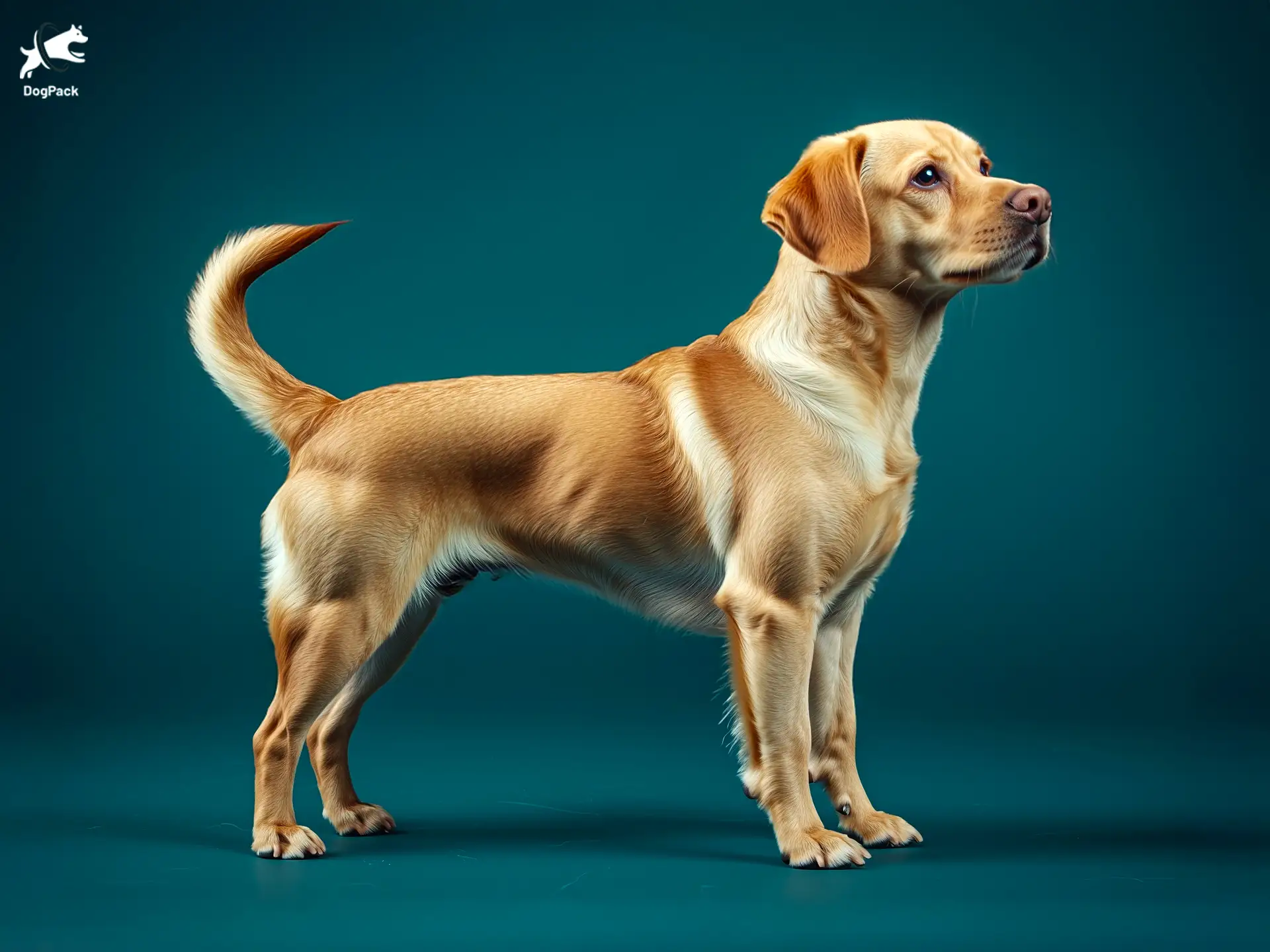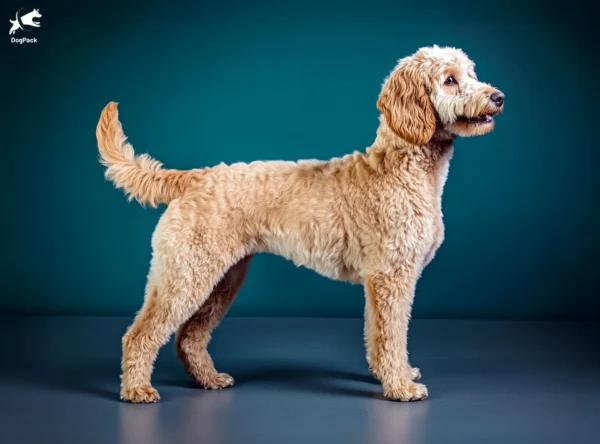Miniature Golden Labrador Dog Breed Info & Overview
The Miniature Golden Labrador (Mini Goldador) is a friendly, outgoing hybrid that blends the affectionate nature of the Golden Retriever with the eagerness of the Labrador. This “mini” version retains the charm of its larger counterparts in a more compact size, making it an ideal fit for active families. Loyal and sociable, they thrive in homes where daily play and companionship are a priority.
Characteristics
Pictures
Breed History
Long before the concept of miniaturizing popular dogs took hold, Labrador Retrievers and Golden Retrievers were prized for their hunting prowess and gentle dispositions. In modern times, enthusiasts wanted a smaller companion with the same dependable traits. Over time, selective breeding produced the Miniature Golden Labrador, a new variation that aimed to capture both breeds’ best qualities in a more compact package.
The creation of this designer mix tapped into the popularity of both parent breeds. Golden Retrievers originated in Scotland for retrieving game from land and water, while Labradors arose in Canada with a similar sporting purpose. By blending these lineages, breeders hoped to retain the top-notch retrieving skills, loyal nature, and easygoing temperament that made each parent so beloved in canine circles.
Although the Miniature Golden Labrador may not boast an ancient backstory like some purebreds, it has quickly won over modern dog lovers. Its history is young but built on the foundation of two globally adored breeds. While it lacks formal recognition by major kennel clubs, it continues to gain fans who appreciate its lovable traits and the convenience of a moderately sized, athletic companion.
Temperament, Personality
Charming and eager to please, these pups are known for their affectionate nature, making them a delight in homes with children or multiple pets. They’re social by default, often greeting family members with enthusiastic tail wags and a bounce in their step. Early socialization plays a major role in refining this outgoing attitude, ensuring their confidence grows as they adapt to various environments.
Patience and warmth come naturally to them, thanks to the traits passed down from the Golden Retriever side. Their Labrador genes add a splash of playful curiosity, so they tend to be quick learners keen on exploring new sights and smells. Although they thrive on companionship, they also appreciate quiet downtime, making them suitable for homes that can balance active play with relaxed, cozy evenings.
Because of their sociable demeanor, they’re usually friendly toward strangers, but it’s still wise to introduce them to unfamiliar faces gradually. A well-socialized Miniature Golden Labrador is renowned for its adaptability and resilience. While they excel in family situations, they can also be good canine neighbors in a variety of living spaces, provided they receive adequate attention and mental stimulation to keep boredom at bay.
Physical Characteristics
Mini Goldadors usually inherit a sturdy, athletic build, reflecting their sporting heritage. Their height can vary, but they typically present as a more compact version of the standard Lab or Golden. Coats often range from short and dense to slightly wavy, showing off shades of gold, cream, or light brown. This sleek appearance pairs well with their smooth, powerful stride and expressive, almond-shaped eyes.
Don’t be fooled by the “miniature” label—these dogs can still weigh up to 75 pounds, though most sit comfortably at the lower end of that range. Their ears flop down at the sides, a hallmark of both parent breeds, and their tails are often thick at the base, thinning out toward the tip. This tail, frequently wagging, is a telltale sign of their friendly temperament.
The typical expression on a Mini Goldador’s face radiates alertness and curiosity. Though some individuals might lean more toward the Golden Retriever’s feathering or the Labrador’s robust frame, the blend usually results in a balanced dog that looks sporty yet approachable. Their double coat provides moderate protection from cold or wet conditions, making them game for outdoor adventures in many climates.
Health Issues
Like any hybrid, Mini Goldadors can inherit health concerns from either parent breed, such as hip dysplasia, elbow dysplasia, or eye disorders. Regular veterinary checkups and early screenings can help catch these issues. Routine x-rays and ophthalmologic exams are often recommended, especially as the dog matures, to maintain joint health and preserve vision quality. Preventive measures are key to a happier, healthier companion.
Obesity can be a problem if their exercise routine is insufficient or if owners indulge in too many treats. Keeping a close eye on their weight and implementing a balanced diet can stave off related conditions like diabetes or reduced mobility. Additionally, ear infections are a common concern due to those adorable floppy ears, so gentle cleaning and vigilant monitoring can help prevent complications.
Allergies—whether environmental or food-related—might also appear. Look for any signs of persistent scratching, rashes, or digestive upsets. Early identification and adjustment of their diet or environment can make a big difference. Staying proactive with vet visits, maintaining proper grooming routines, and offering a healthy lifestyle are your best defenses against these issues, allowing the Miniature Golden Labrador to enjoy a long, active life.
Grooming Needs
A moderate grooming schedule is usually sufficient, thanks to their shorter or lightly feathered coat. Weekly brushing helps remove loose fur and reduces shedding around the house, which is especially handy in spring and fall. A slicker brush or a firm bristle brush can glide through their coat easily, keeping it clean and shiny. This regular maintenance also offers a chance to bond.
Baths can be given monthly or when they’ve indulged in particularly messy outdoor fun. Opt for a gentle dog shampoo that won’t strip the coat’s natural oils. Because of their water-loving heritage, they might not resist bath time too much—just keep the experience positive with treats and praise. After a swim in lakes or ponds, rinse them off to remove any debris or potential irritants.
Don’t forget the ears, nails, and teeth. A quick ear inspection once a week can spot redness or odor that signals infection. Regular nail trims prevent discomfort and maintain healthy paws. Periodic toothbrushing—two to three times a week—helps combat plaque buildup and bad breath. Adhering to a consistent grooming routine keeps your Mini Goldador feeling great and looking picture-perfect year-round.
Exercise Requirements
Mini Goldadors tend to be moderately high-energy dogs that flourish with daily play and walks. They might not require marathon sessions, but they do appreciate structured outings to burn off steam. A brisk walk in the morning or a friendly fetch session in the backyard helps them stay fit and mentally engaged. Pair these activities with puzzle toys to challenge their sharp minds.
Swimming is a big hit with many of these pups, courtesy of their water-retriever ancestry. A quick dip in a safe, supervised environment offers both exercise and a cool-down on warm days. If water sports aren’t an option, try an agility course or light jogging by your side. The key is variety—keeping them guessing ensures they remain excited about each new activity.
Adequate exercise not only helps maintain a healthy weight but also discourages destructive behaviors. Bored dogs can get into mischief—chewing shoes, digging holes, or barking excessively. By offering a mix of physical and mental stimulation, you’ll have a more contented and well-behaved Miniature Golden Labrador. If you have a busy day, interactive toys or treat-dispensing puzzles can step in and provide some extra engagement.
Training Tips
With intelligence inherited from both parent breeds, training tends to be straightforward. Positive reinforcement methods—treats, praise, gentle encouragement—work wonders. Consistency is key, especially during puppyhood, to prevent the development of unwanted habits. Start early with basic commands such as “sit,” “stay,” and “come,” building a solid foundation for advanced training as your pup grows more confident and eager to learn.
This mix is particularly receptive to tasks and challenges, so incorporating interactive sessions—like retrieving hidden objects—can keep them mentally stimulated. Patience goes a long way, as occasional stubborn streaks might surface. Short, engaging sessions typically trump long, repetitive drills. They pick up cues quickly, but they also appreciate variety to maintain their curiosity and motivation throughout the learning process.
Socialization is just as vital as obedience work. Introduce your Miniature Golden Labrador to various people, pets, and settings to build confidence and reduce anxiety. Overcoming any timidness or over-excitement around new friends early on fosters a balanced temperament. Group puppy classes or canine sports clubs can further hone their social skills while nurturing that signature enthusiastic spirit.
Nutrition, Diet
Mini Goldadors thrive on nutrient-dense kibble specifically formulated for medium, active dogs. Look for diets containing a balance of protein—like chicken or fish—and healthy fats to support their energetic lifestyle. Puppies require slightly higher protein to fuel growth, but once they mature, switching to an adult formula helps maintain lean muscle without packing on extra pounds. Avoid cheap fillers that provide empty calories.
An adult Mini Goldador typically does well with two balanced meals per day, each ranging from 1.5 to 2 cups of high-quality food, depending on activity level and metabolism. Split portions keep them satisfied without overburdening their digestive system. Keep an eye on treat consumption; a few small, wholesome snacks or training rewards per day are plenty to reinforce good behavior.
For especially active or working Mini Goldadors, consider foods fortified with joint-supporting supplements such as glucosamine and chondroitin. Monitoring their weight is vital—Labrador genes are famous for big appetites. If you notice weight creeping up, reduce portion size slightly or switch to a lower-calorie formula. Always provide access to fresh water, particularly after exercise or during warmer months, to keep them hydrated and healthy.
Adoption, Breeders
If you’re looking to adopt, check local rescues or specialized groups dedicated to retriever mixes. Some Labrador or Golden Retriever rescue organizations also list hybrid varieties, including this Mini mix. These groups often feature foster programs, allowing you to meet the dog in a relaxed home setting before making a commitment. Adoption can be a rewarding option, giving a loving pup a second chance.
For those seeking a breeder, focus on reputable sources that prioritize health testing and humane breeding practices. A transparent breeder should willingly share details about parent dogs, including health clearances. Visiting the facility—or scheduling a virtual tour—helps confirm living conditions and ensures pups are well-cared for. Engage with breeders who demonstrate genuine passion for the breed and are prepared to answer all your questions.
Check out Petfinder or Adopt a Pet for adoption listings and further guidance. Additionally, many breeder directories include reviews and references from past clients, offering insight into the breeder’s reputation. Remember, a Miniature Golden Labrador can be a decade-long commitment or more. Selecting the right source sets the stage for a strong bond and a healthy, thriving companion.
Family Pet?
Mild-mannered yet brimming with enthusiasm, these dogs suit many family dynamics. They typically adore kids, especially those who enjoy tossing a tennis ball or going for quick backyard play sessions. While boisterous play is part of their charm, teaching children proper dog etiquette—like gentle handling and respecting personal space—goes a long way toward ensuring positive interactions for everyone involved.
Families that appreciate outdoor activities, from park strolls to lakeside fetch, will find a great match in this cheerful companion. Even in more laid-back households, the Mini Goldador’s adaptability shines, as they’re content to curl up and watch family movie night—after sufficient exercise, of course. With consistent attention and a loving environment, they integrate seamlessly into a bustling family life.
Their penchant for friendliness often extends to feline friends, especially if introduced from a young age. If your existing pets enjoy company, a Miniature Golden Labrador can be the perfect new pal. By setting boundaries, offering safe zones, and supervising early interactions, your cat and dog can learn to coexist happily. This breed tends to be peaceable, making them a welcome addition to most multi-pet households.
Right For You?
Before inviting one into your home, consider whether you can meet their moderate-to-high exercise needs. Active individuals or families who delight in daily walks, jogs, or playful backyard sessions will complement the breed’s enthusiasm. Consistent training, gentle leadership, and a patient approach keep these dogs mentally engaged and well-mannered. If you cherish companionship and can dedicate time to exercise and bonding, they might be ideal.
For those pressed for space, a Mini Goldador may still fit if you’re diligent about providing play opportunities. A cozy apartment can work if you’re up for multiple outdoor activities and plenty of social interaction. On the flip side, a yard isn’t a free pass for ignoring them—they need human connection. Evaluating your lifestyle honestly helps ensure you and your new dog remain a happy team.
When deciding, think about grooming, budget for vet care, and any potential limitations on your time. Travel frequency or long work hours might strain this breed’s well-being unless you arrange dog walkers or sitters. Overall, the Miniature Golden Labrador thrives where its friendly, outgoing spirit is embraced. If that aligns with your circumstances, you may find the perfect four-legged addition to your household.
Conclusion
With its warm demeanor and sociable, playful energy, the Miniature Golden Labrador offers the charm of larger retrievers in a somewhat more compact frame. For active families or individuals seeking a devoted companion, this breed’s intelligence and loyalty rarely disappoint. If you can provide daily exercise, proper training, and regular affection, you’ll be rewarded with an enthusiastic, tail-wagging friend who cherishes every shared moment.
FAQs
-
Is the Miniature Goldador a purebred dog?
No, the Miniature Goldador is a designer hybrid—a mix between a Labrador Retriever, Golden Retriever, and sometimes a Cocker Spaniel or Poodle. The goal is to create a smaller version of the Goldador while retaining its friendly temperament and intelligence.
-
How does a Miniature Goldador compare to a full-sized Goldador in energy levels?
The Mini Goldador typically has moderate energy levels, needing daily exercise but often requiring less than a full-sized Goldador. Depending on the mix, those with more Poodle or Cocker Spaniel genetics may have higher energy or more independent streaks.
-
What is the average size of a fully grown Miniature Goldador?
A Mini Goldador typically weighs between 25-50 pounds (11-23 kg) and stands 14-20 inches (35-50 cm) tall, depending on its genetic makeup. Those with more Cocker Spaniel genes may be smaller, while those with more Retriever traits may be closer to 50 pounds.
-
Does the Miniature Goldador shed a lot?
Shedding depends on genetics. Mini Goldadors with more Labrador and Golden Retriever traits will shed moderately to heavily, while those with Poodle influence may shed significantly less. Regular brushing 2-3 times per week helps keep shedding manageable.
-
Is the Miniature Goldador recognized by major kennel clubs?
No, the Mini Goldador is not recognized by the AKC or FCI, as it is a hybrid breed. However, some hybrid registries, such as the Designer Breed Registry (DBR) and ACHC, track their lineage and breeding history.
Breed Ratings
The Miniature Golden Labrador excels at learning new commands and tasks, making training a fun and rewarding process.
Eager to engage in fetch or tug-of-war, this mix stays playful without overwhelming owners seeking occasional downtime.
Daily walks or runs are important for keeping them fit and well-behaved, though they can enjoy indoor relaxation afterward.
Moderate shedding means regular brushing helps keep fur off your sofa and ensures a neat appearance.
They may show curiosity toward small animals but generally aren’t high-strung about chasing everything in sight.
Simple brushing and routine bathing usually suffice, and their coats are easier to maintain than heavier, longer-haired breeds.
Quick learners with a strong desire to please, they respond well to consistent, positive reinforcement methods.
They prefer company but can handle brief periods alone if provided with toys or puzzles for mental stimulation.
Typically quiet, though they may bark to alert you of visitors or unfamiliar noises.
Some drooling may occur, especially around mealtime, but overall it’s manageable.
Sociable and playful, they get along with many canine pals if introduced properly.
Usually robust with good care, but routine vet visits and monitoring for joint or eye issues are essential.













